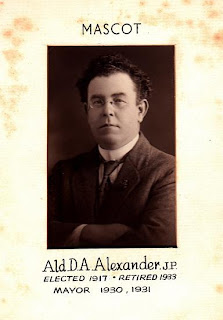One of the most dramatic changes to shopping in the Botany area in the 1980s was the development of the Westfield Shoppingtown in Eastgardens.
The Mascot Library and Museum is currently running an exhibition on shopping in Botany and Mascot
Tuesday, 27 March 2012
Tuesday, 21 February 2012
Searl and Sons' Botany Nursery
Searl and Sons was a large nursery, florist and seedsmen company, started by Frederick Searl and his two boys, John Thomas and Frederick Henry in 1867. They had a top retail location in George Street, Sydney, where the Queen Victoria Building is currently located. The company were growing flowers from nurseries in prime land near Parramatta and later Newtown.
In June 1887 Frederick and John Searl, together with John’s father-in-law William Stabback, purchased 23 acres in Banksmeadow, near Smith Street, Botany. They paid 736 pounds, 14 shillings and 9 pence for the land.
The area was prime land for many growers like market gardeners, farmers and nurserymen. The Botany area was low lying and the soil was very good for productivity. One other feature of the area was the abundance of natural water.
Searl & Sons developed a nursery over 17 acres of the land and produced flowering shrubs, ornamental trees, fruit trees and flower plants. There was also a cottage, stable, glasshouse, containing a large variety of orchids, and other greenhouses on the land.
 |
| Searl & Sons Botany Nursery |
Frederick, John and later Frederick’s son William took great care in developing the Botany nursery and it became a showpiece for Searl & Sons, being regarded as one of the largest and most impressive nurseries of its kind in the Commonwealth.
The company even started to show visitors around the spectacular nursery, often meeting people off the tram and driving them to the site. However, it was advised to give good notice of arrival.
Searl & Sons began to fall into serious financial trouble after the death of Frederick Henry Searl in 1920. The next generation were struggling to keep the business afloat without the guidance of the more experienced Searls. In 1922, after holding a large number of stores and producing nurseries, only the Botany Nursery remained in Searl’s ownership and contributed produce for the business.
On August 13 1925 Searl & Sons transferred all assets to a public accountant for benefit of the company’s creditors. Due to this the Botany Nursery was sold at auction, ending the Searl’s involvement in it.
Wednesday, 18 January 2012
The Roads of Change - Botany Road, Mascot
Botany Road has seen many changes throughout its history. Yet it still remains one of the most unique and important main roads in Botany and Mascot. These pictures show some of the change the road has seen over the last 70 years.
This image shows Botany Road, Mascot, looking north from 1938.
This image, from a similar position, shows the same stretch of road from 2011.
This image shows Botany Road, Mascot, looking north from 1938.
This image, from a similar position, shows the same stretch of road from 2011.
Sunday, 8 January 2012
David Alexander - Lauriston Park's Greyhound Legend
David Alexander was one of the village of Lauriston Park’s champions during its push for development and change. The small village, located where the Sydney domestic airport is currently located, had a very tight community however they often had to struggle for developments and improvements in the area, such as sewerage and lighting.
David was always at the forefront of lobbying for the village.
He was elected to the Council in 1917 and a monthly meeting rarely went by without him pointing out to the rest of the council the problems and issues at the Lauriston Park estate.
He eventually became Mayor from 1931 -1933 and continued his push for focus on Lauriston Park.
His family donated the land for the Lauriston Park Hall in 1914. His residence was on Ross Smith Avenue, at the North end of Lauriston Park.
David Alexander was also very active in the Greyhoud Racing Industry of NSW. He was the founder/first editor of Australia’s highest selling greyhound newspaper, the Greyhound Recorder - a famous publication in the greyhound racing industry.
The Dave Alexander Memorial, which was run at Harold Park and later switched to Wentworth Park, was named after him.
Subscribe to:
Comments (Atom)





